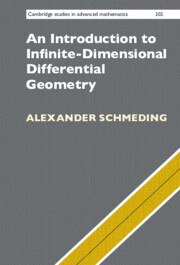Book contents
- Frontmatter
- Contents
- Preface
- 1 Calculus in Locally Convex Spaces
- 2 Spaces and Manifolds of Smooth Maps
- 3 Lifting Geometry to Mapping Spaces I: Lie Groups
- 4 Lifting Geometry to Mapping Spaces II: (Weak) Riemannian Metrics
- 5 Weak Riemannian Metrics with Applications in Shape Analysis
- 6 Connecting Finite-Dimensional, Infinite-Dimensional and Higher Geometry
- 7 Euler–Arnold Theory: PDEs via Geometry
- 8 The Geometry of Rough Paths
- Appendix A A Primer on Topological Vector Spaces and Locally Convex Spaces
- Appendix B Basic Ideas from Topology
- Appendix C Canonical Manifold of Mappings
- Appendix D Vector Fields and Their Lie Bracket
- Appendix E Differential Forms on Infinite-Dimensional Manifolds
- Appendix F Solutions to Selected Exercises
- References
- Index
3 - Lifting Geometry to Mapping Spaces I: Lie Groups
Published online by Cambridge University Press: 08 December 2022
- Frontmatter
- Contents
- Preface
- 1 Calculus in Locally Convex Spaces
- 2 Spaces and Manifolds of Smooth Maps
- 3 Lifting Geometry to Mapping Spaces I: Lie Groups
- 4 Lifting Geometry to Mapping Spaces II: (Weak) Riemannian Metrics
- 5 Weak Riemannian Metrics with Applications in Shape Analysis
- 6 Connecting Finite-Dimensional, Infinite-Dimensional and Higher Geometry
- 7 Euler–Arnold Theory: PDEs via Geometry
- 8 The Geometry of Rough Paths
- Appendix A A Primer on Topological Vector Spaces and Locally Convex Spaces
- Appendix B Basic Ideas from Topology
- Appendix C Canonical Manifold of Mappings
- Appendix D Vector Fields and Their Lie Bracket
- Appendix E Differential Forms on Infinite-Dimensional Manifolds
- Appendix F Solutions to Selected Exercises
- References
- Index
Summary
In this chapter, one aim is to study spaces of mappings taking their values in a Lie group. It will turn out that these spaces carry again a natural Lie group structure. However, before we prove this, the definition and basic properties of (infinite dimensional) Lie groups and their associated Lie algebras are recalled. Infinite-dimensional Lie theory (beyond Banach spaces) is by comparison relatively young and in its modern form goes back to Milnor’s seminal works. One key feature of infinite-dimensional Lie theory is that the conncection between Lie algebra and Lie group is looser then in finite dimensions. For advanced tools in Lie theory one has to require the Lie group to be regular (in the sense of Milnor). These concepts are introduced and considered for several main classes of examples, such as the diffeomorphism groups, loop groups and gauge groups.
Keywords
- Type
- Chapter
- Information
- Publisher: Cambridge University PressPrint publication year: 2022
- Creative Commons
- This content is Open Access and distributed under the terms of the Creative Commons Attribution licence CC-BY-NC-ND 4.0 https://creativecommons.org/cclicenses/

